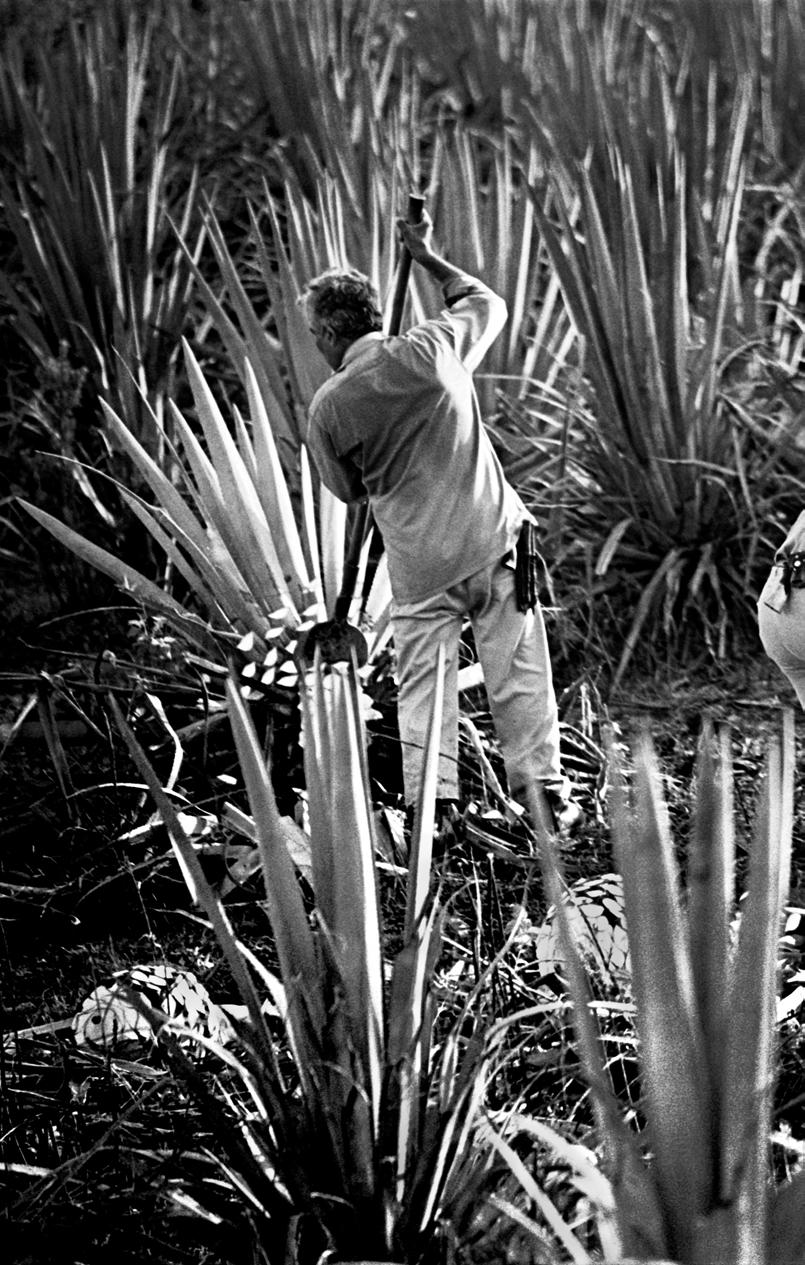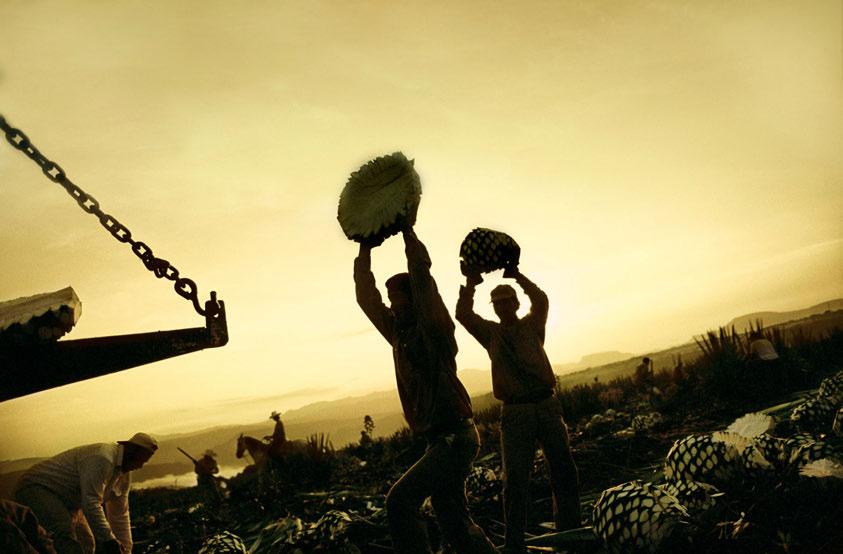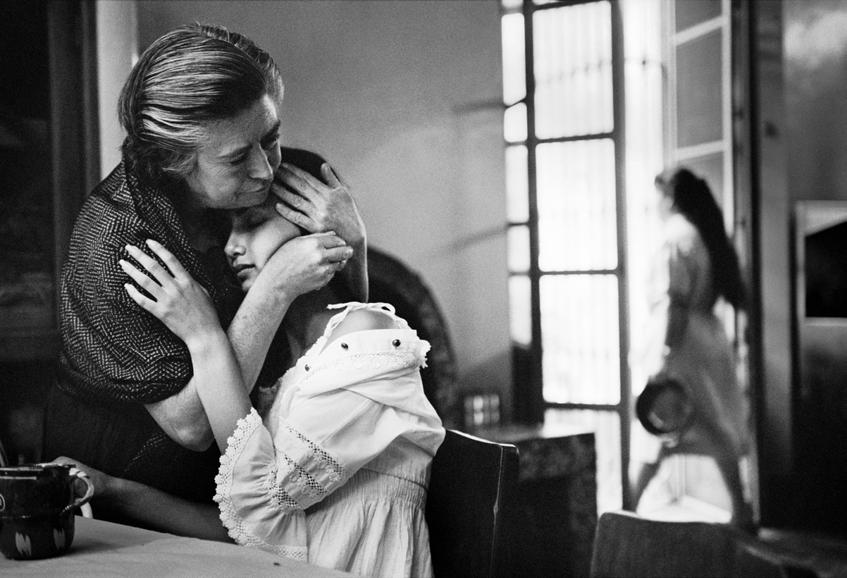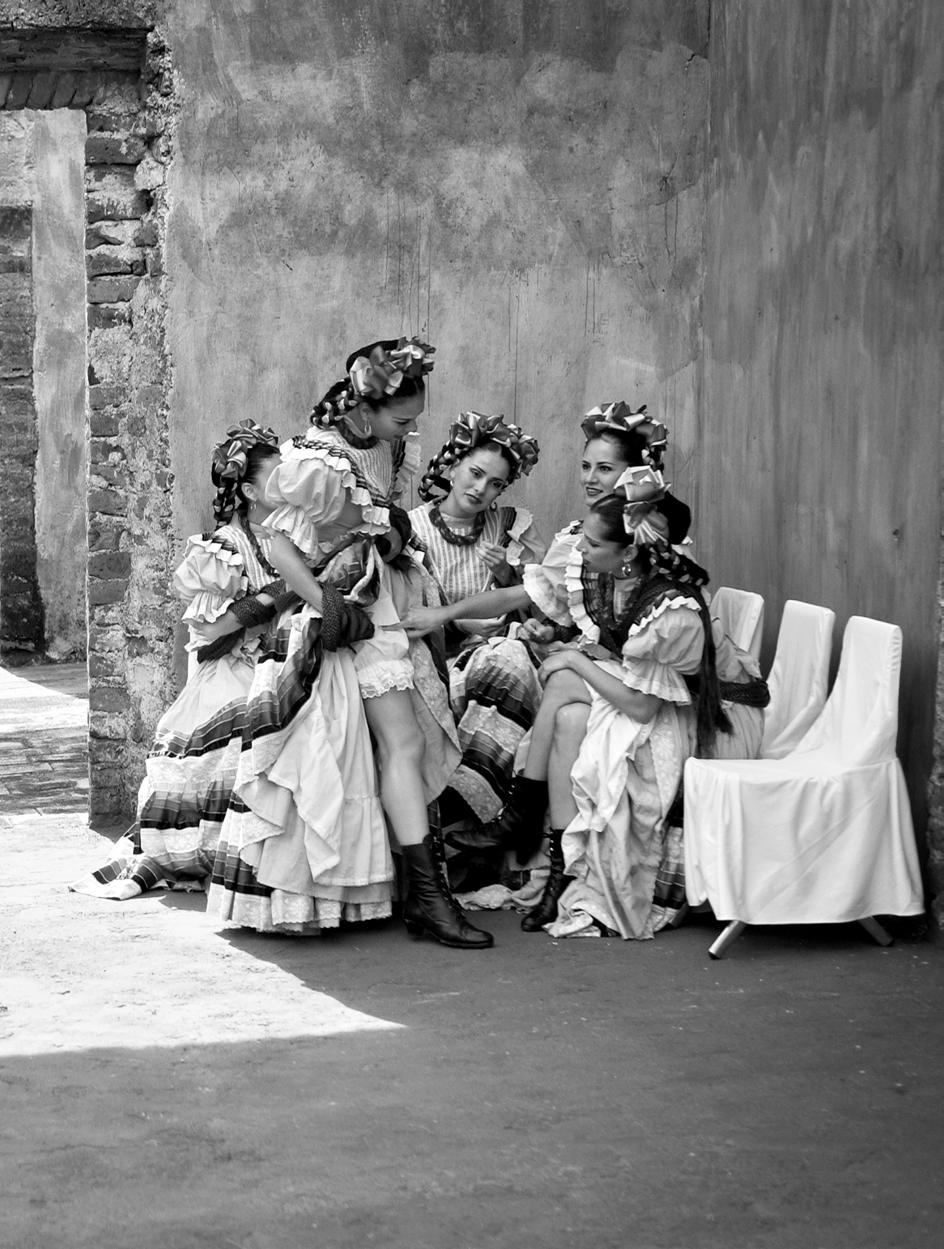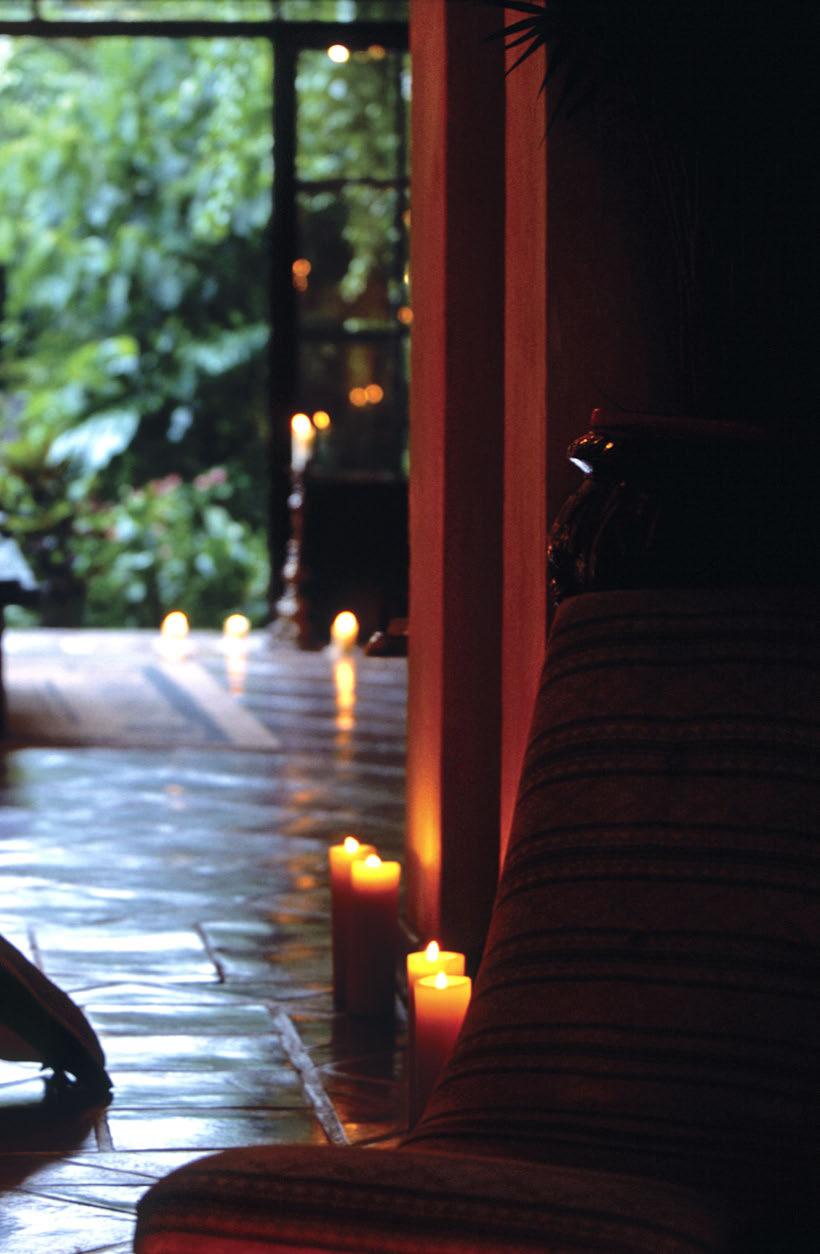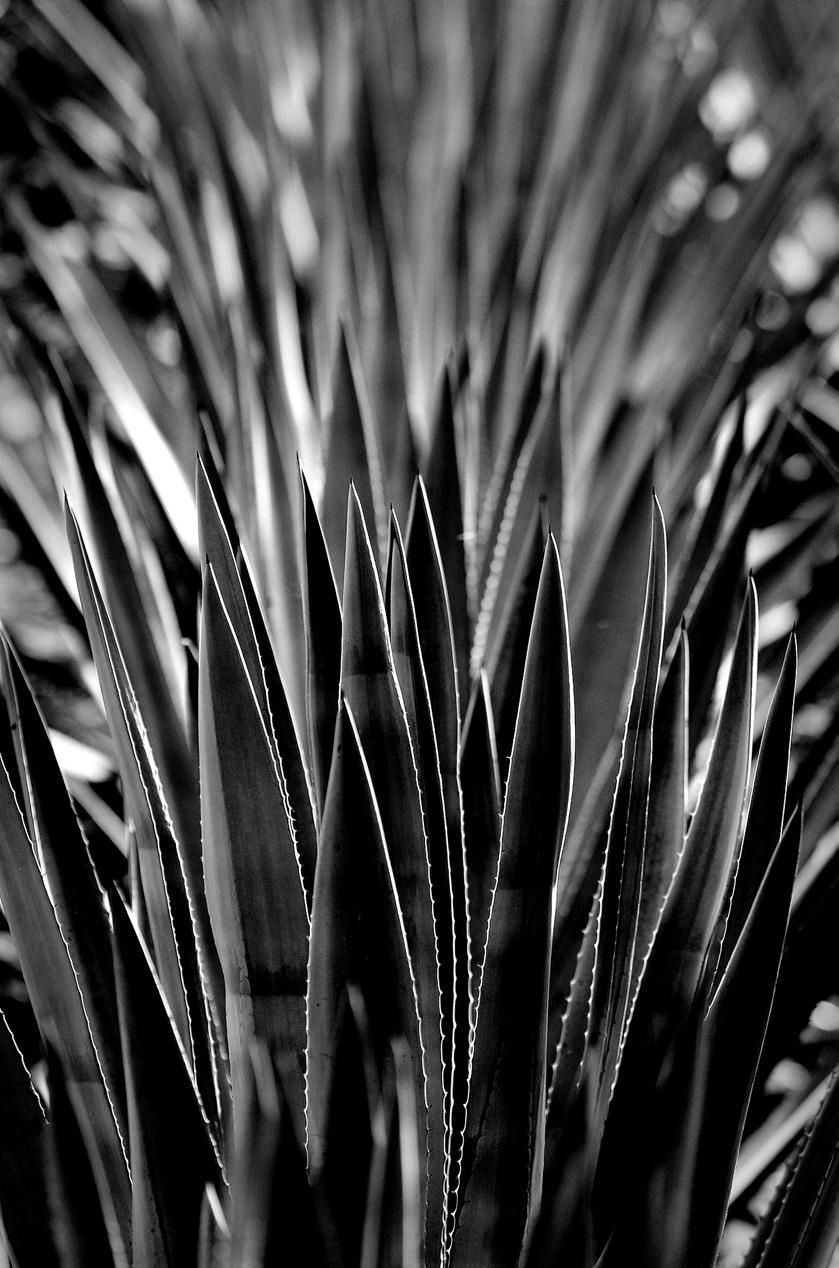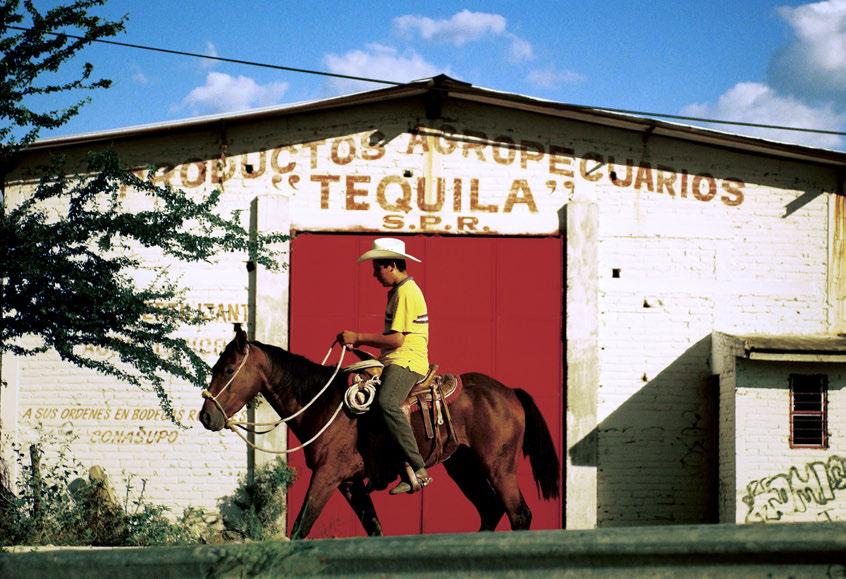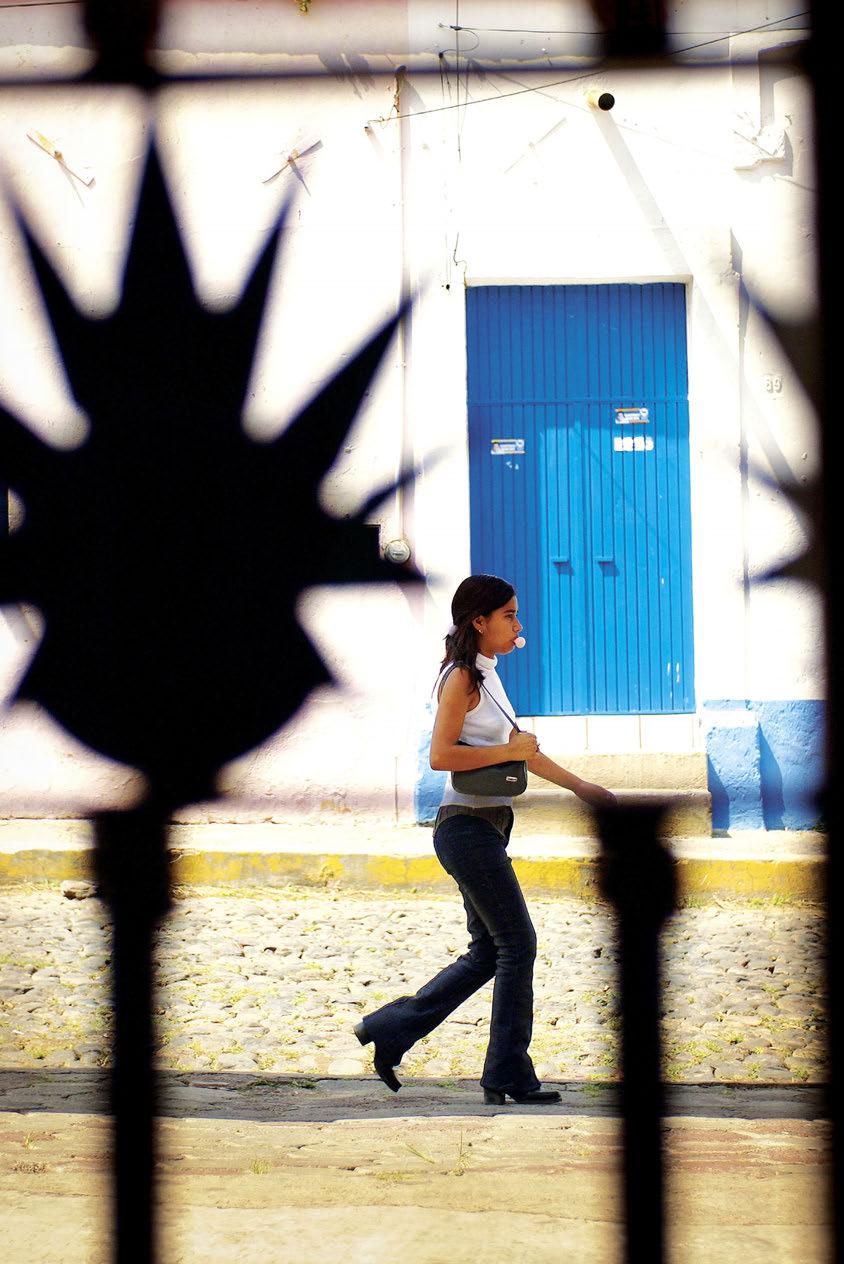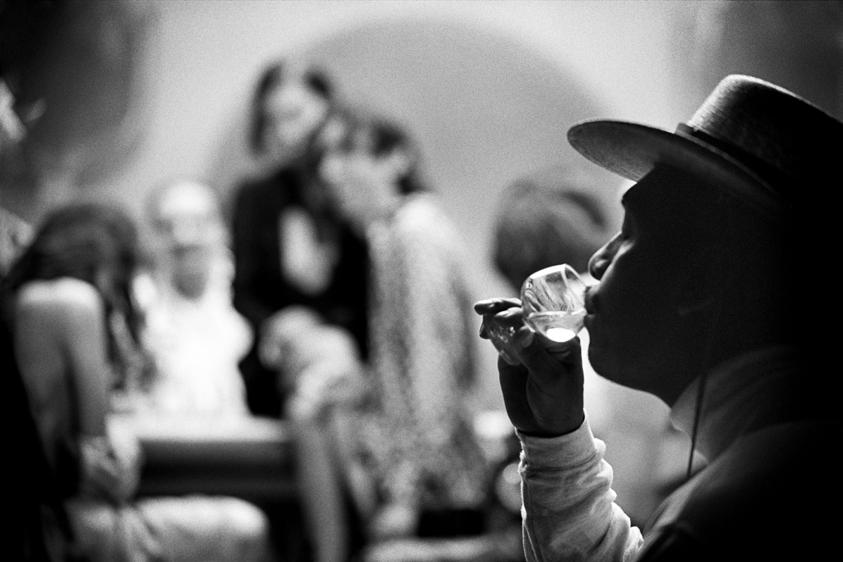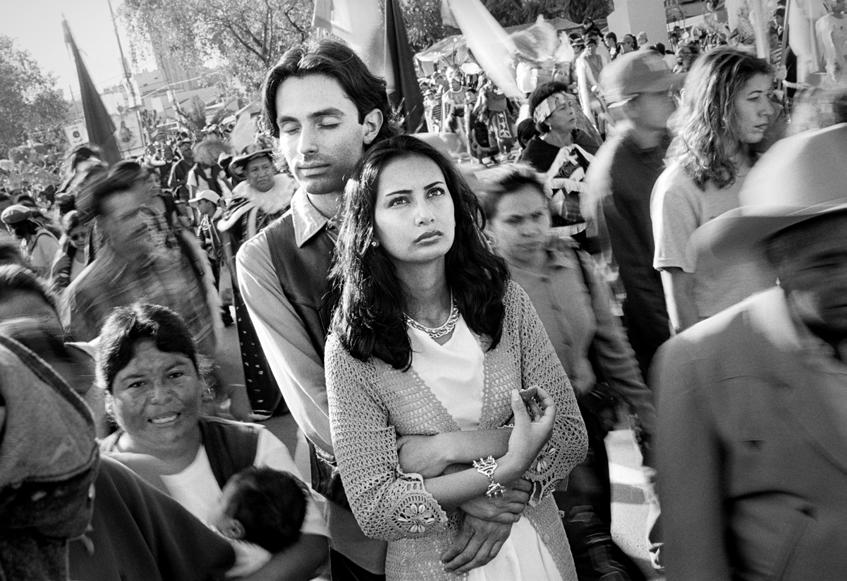E.VILLASEÑOR
Art Directed by Andrés Zamudio Produced by Ellen Erwitt
Text & Photographs by Doug Menuez
“Es su compadre, su confesor, su cura. El tequila es la única cosa de su vida.”
– Andrés Zamudio
WHILEREADING SALMAN RUSHDIE’S THE GROUND BENEATH HER FEET, I WASSTRUCK by a scene in which an Indian rock singer visits a distillery in the Méxican town of Tequila and sees naked men in vats of agave juice making tequila. First, I thought the image too precise and unexpected to be completely fictional, and imagined that Mr. Rushdie must have observed this himself. Second, who knew there was an actual town named Tequila?
Intrigued, I asked my friend Andrés Zamudio, a Méxican art director living and working in New York City, what he knew.We met at a bar in SoHo, and over a bottle of good tequila I listened intently as he spoke aboutits meaning in Mexican culture. “ To understand México, you must understand something of tequila and tradition,” he said. “Tequila was a gift from the gods to the Aztec, a sacrament to be respected, which it remains today. Yes, we know how to enjoy ourselves, but it’s much deeper than that,” he explained. He related stories of his family and friends on their ranch in Northern México, and how important this ancient liquor was to them and to all Mexicans. “Tequila is México,” he stated simply.He had not, however heard of a technique for making tequila involving naked men in vats, and was skeptical.Over our last shot, we resolved to find out if such a technique existed, and, if so, where such a distillery could be found. We both felt that whatever we found would be well worth learning about and photographing.
We finally found a distillery in Jalisco state that still used this traditional technique. We headed to the town of Tequila, with a loose plan to shoot the land, the hacienda, and everyday life of the people we met, sampling the purest blue agave tequila along the way. We hoped to capture a sense of place and something of the history of tequila and of México. We did not realize how a simple quest would lead to a journey of discovery. I thought I knew México—I was born on the border and have photographed there for decades. Andrés was born and raised in Durango—but after learning just a little about tequila, we quickly understood that neither of us actually knew much about the extremely complex history and mestizo culture of México.
Tequila opened our hearts to another México: an enduring, ancient place, where, 500 years after the European conquest the spirit, pride and passion of the people continue undiminished. A land where, despite all the contradictions and struggles for political and economic justice, anything is possible. What follows here is accurate in spirit if not perfectly accurate, as we tasted much of what the gods left the Aztecs.
— Doug Menuez
Thetruck jumps awkwardly off the highway into a field, running in between the tall rows of mature agave.The harvest is in full swing, with men spread across a wide swath. The sun quickly lifts higher, turning the rich dark soil redder by the minute as it clears the ridgeline. These men work the fields 364 days a year. Their only holiday is El Dia de La Virgen de Zapopan, a religious festival and parade, which is to be held on the following day in Guadalajara. The first line of jimadores move down the rows, hacking off the sharp five foot tall leaves that make the agave look like a cactus, to reveal the sweet piña, the heart from which the sap is crushed.
Each agave seedling is cultivated at the hacienda, and is known by the tequila makers as having descended from a previous worthy ancestor. Only the very best are individually selected from thousands of lesser buds, and then planted by hand. This detail seems impossible to believe, as the slightest turn of the head reveals thousands upon thousands of plants pushing up from tidy, endless rows in all directions. The men are called jimadores after the cao de jima, sharp-edged tool they use.
Other men stoop and pick up the piñas, tossing them overhead from man to man. The piñas bounce along like punk rockers atop a mosh pit until they finally hurtle into the back of a waiting truck. As the heat rises it’s time for a break. The men stop to make fires of the cut agave spikes to cook rough breakfasts of tortillas, chicken, cheese, and beans. They swig campo coffee from canteens, quietly eating and talking.
Itis dark and cool inside the old distillery, built of stone and bricks turned black from years of crushing, boiling, burning, and cooking.
In the first room is a low, circular grinding floor where a giant stone is pushed around a post to crush the hearts of agave after they have been roasted. At different times this stone was pushed by men, burros, and more recently, a tractor. Today men are pushing the stone. The juice runs into the next room through pipes in the floor. Through the stone archway there are more workers, tequileros, naked in pits in the floor, working the must––fresh agave juice mixed with the pulp of the piñas––by hand and foot in the traditional manner. They stir the must with their bodies to encourage fermentation and to separate strands of fiber and other leafy matter which they pull from the pulpy liquid.
The men are naked partly because of traditions going back before the Aztec, who dug pits in the earth. Historians say that this practice most likely evolved because of the naturally occurring yeasts on skin that start fermentation, similar to using bare feet to crush grapes in Italy. Modern methods will soon replace this ancient tradition.



Atrue hacienda requires a thousand workers, a thousand head of cattle, a thousand hectares, a working business, and, most important of all, a chapel.It was the chapel that allowed this hacienda to grow by trading its use for weddings in exchange for land. The haciendado built the chapel even before the hacienda was complete. With each request by a local family to have their children’s baptisms and weddings performed there, he would slaughter a cow, then make from its hide a long string. He attached this cowhide string to a stick and laid it across the land, pacing off a parcel that would then become his. Plot by plot, he amassed land in this way over the years.
This story contrasts sharply with the way many otherhaciendados created their domains. They often forcefully took land as they wanted, usually from Native Méxicans and small villages. Still, the vast majority of haciendas disappeared in the Méxican Revolution and through various agrarian reforms in the years that followed. Today, weddings are still performed in the chapel here.
Inevery plaza the Méxican flag is always flying, unfurling its archetypal storyboard, mostly unobserved, but worth a closer look. An extremely violent scene, nature at its most instinctive, sits at the center. It depicts an eagle fighting a snake— the struggle for life and death. The green, white and red colors of the flag symbolize hope, purity, and the blood of the heroes who fought for independence.
According to legend, the gods had advised the Aztecs that they would know the place to build their city when they saw an eagle perched on a prickly pear tree, devouring a serpent. The Aztecs saw this mythical eagle on a marshy lake that is now El Zócalo, the main plaza in México City. The eagle on the flag is terrifying in its beauty and power, mercilessly ripping apart the snake. A primal symbol reflecting the reality of life on earth, especially here in México.
Like champagne, tequila is tied to the region in which it is made. To be legally branded tequila, the product must be grown in Jalisco state or in the nearby states of Guanajuato, Tamaulipas, Michoacan, and Nayarit and fermented with at least fifty-one percent blue agave juice (Agave tequilana Weber).There is evidence that agave has been cultivated in México for more than 9,000 years. The juice was fermented into “pulque” to drink and was the first known alcohol of the Americas.
It was the Conquistadors in the 1500s who first made the local pulque into mezcal wine, later called tequila—in the town they founded and named Tequila at the foot of the volcano. There are various theories about the origins of the word tequila and how the spirit, town, and volcano all got named. It probably came from the Nahuatl language, spoken by the Aztecs and the tribe who lived here and grew the agave before the Aztecs dominated the region. The ground is littered with their black obsidian arrowheads and chips. According to one local legend, the Nahuatl word tequitl means “rock that cuts” and the men who made these arrowheads were called tiquilos.
The Nahuatl also worshiped the goddess Mayahuel, who represented agave. She had 400 breasts that oozed pulque. Today the Nahuatl language is still spoken by over one million people descended from the Aztecs and pulque is still made in villages. It is estimated that today there are 89 indigenous languages spoken by 62 tribes across the country. You can travel over any mountain range and find a unique language, food, clothing and traditions. Yet across this vastly diverse country it is tequila that remains a constant. It unifys and connects this complex Méxican culture.
Forthe blissfully ignorant traveler, México can seem a fulfillment of low expectations. They don’t expect to see more than their preconceived ideas, and they prefer to stay within their tourist bubble. But an open-minded visitor can easily learn about the deeper roots of the culture.
The true story of México is very subtle, a complex history made even more so by revisions of prior events by the victors of each era. Even the Aztecs destroyed their own nomadic history, choosing to adopt the gods of the Toltec who came long before. The Spaniards then tried to erase Aztec history and ruled for 300 years before being overthrown in the War of Independence of 1810–1821. They were followed by the Americans, whose immigrants to México’s territory of Texas fought at the Alamo in 1836 for the right to keep slaves, despite México’s laws against it. Then, in 1848, after the US invaded and conquered México it took a massive section of the country, which had included the previously annexed Texas, plus Nevada, Utah, Arizona, New Mexico, California, Wyoming, and part of Colorado—half the original territory of México.
Today Méxican third graders learn this history and look north, knowing that almost half of the US was once their land.
Then came the French, who in 1862 installed the ill-fated Emperor Maximilian. The French were overthrown five years later, followed by various civil wars and a ruthless dictatorship led by Porfirio Díaz that lasted 34 years. This was followed by the bloody hell of the Méxican Revolution from 1910-1920, which led to 70 years of single-party rule until 2000 with the election of Vincente Fox. Since then, the original ruling party has re-gained control.
Thebar is not really open this early in the afternoon. Except for one older man sitting in the corner alone, it is quiet and empty.Formerly a famous bullfighter hangout, El Bar Maestranza is where the local legends came to celebrate after historic fights. The best bulls’ heads are stuffed, and hang ominously over the bar, their huge eyes permanently alert as if sensing the provocative matador.
Soon, a group of young people arrive, trooping up the stairs, laughing and talking, calling friends on their mobiles. One of them, a longhaired man with a friendly face, places five bottles of blue agave tequila on the bar, all different types—a few blancos and reposadas with an añejo. He begins making friends as he lines the bottles up on the bar. A woman grabs a knife from the bartender and begins to cut quarters of fresh limes, laying them out in rows. Little bowls of salt appear. Norteño, the mournful music of Northern México begins to play. Meat is set on spits in the wood oven and smoke fills the room.
The empty bar is filling up and soon there is a party underway, everyone furiously smoking and drinking. After only twenty minutes, the five bottles are empty, everyone is singing at the top of their lungs and one of the young women is beginning to dance on the bar.



An hour before dawn on El Dia de la Virgin de Zapopan and the bars of Guadalajara have emptied into the streets. Drinkers, dancers, philosophers, lovers, and fighters—the whole town, young and old, is out here today. Penitents on their knees are crawling the ten miles uphill to the church. Some have blood on their hands and faces. Others are whipping themselves, praying fervently. Following behind are Native Méxicans––descendants of the Aztec, the Nahuatl, Olmecs, Mayans, Toltecs, and many others—living reminders of México’s huge indigenous population, mostly unseen by tourists in the main cities or beaches. These are the descedants of the people the Spaniards conquered, yet they endure, dancing and singing in their original languages and costumes. The men from the agave fields are also here with their families, their one single day off in an entire year of labor. Despite the symbolic violence of the penitents, the mood remains joyfully upbeat.
The surging crowd is approaching rapture as the word passes that the Virgin is coming. Long ropes on either side are being passed up the avenue, a space is cleared in the center for the procession. Eventually the Virgin comes into view, dawn light slashing across a small white adorned statue atop a large heavy box being carried by a dozen men. A woman close by blesses herself and begins to pray. The man with her does the same as thousands nearby follow suit. A woman, her face covered in blood, smiles blissfully as the crush of people eases a fraction. A man in a skeleton death mask pauses, mildly threatening. The mask and its owner move on, following the Virgin into the crowd.
“We are the children of Quetzalcoatl, the Plumed Serpent. He is our creator.”
VICTOR E. VILLASEÑOR
Los Altos de Jalisco.
México! México! méjico! The land oF My FaTher and MoTher! The land of el mestijo–the blending of European and indigenous bloods. The land of a thousand stories, and some of them so huge and wild and incredible that they rival the Bible for power and the ingenuity of humankind.
For instance, I was just a little kid growing up in the Oceanside-Carlsbad area of San Diego County, California, when my father—an ex-bootlegger—explained to me that the only reason we lost the Garden of Eden was because there was no tequila.
“Listen to me closely,” he said to me, “if I’d been the local bootlegger back in the Garden, I would’ve sold a bottle of tequila to Adam. Good tequila. The best. From Los Altos de Jalisco. And Adam would’ve had a couple of good big shots, then when God came down and asked him who did it, Adam would’ve pushed back the rim of his hat and told God straight in the face, ‘I did! So what? Yo lo ise, y que?’ God would’ve been taken aback. He would’ve looked at Adam more closely, and He would’ve seen that Adam was willing to defend his bride, his woman, at all cost. This would’ve moved God’s heart, so He would’ve said, ‘What are you drinking, Adam?’ And Adam would’ve said, ‘Tequila!’ And God would’ve said, ‘Let me try some,’ and God would’ve loved it, and we’d all still be in the Garden drinking tequila with God and feeling pretty damn good!
“You see, mijito, tequila is the only thing that is missing from us bringing Heaven down here to Earth, uniting us with the Almighty once again. God doesn’t like cryba bies. God likes men who are men, and willing to defend their loved ones with both of their tanates in hand. This is the spirit de Mejico! This land that used to be the passageway from South America to North America for tens of thousands of years before the Europeans ever came. That’s why my mother from Oaxaca, God bless her soul, explained to me that parrot feathers from South America can still be found as far north as Canada, taken there by traveling wise men and women.”
Then my dad would tell me other stories about México and how his aging mother had always poured a little bit of tequila into her coffee to sip while she sat in the outhouse praying to God at sunrise with her Bible and rosary. I was twelve years old when our father finally took our whole family to his homeland of Los Altos de
Jalisco. We visited the town of Tequila and saw how the tequila was made. We traveled to my dad’s village of Arandas and we walked through the fields of the agave plants, the blue-gray cactus-like plant that the tequila is made from by cutting away the leaves and boiling the heart, producing a thick, honey-like syrup with a deep, earth-like smell and taste. He pointed to a hillside just east of town and told us how his father, a tall handsome redheaded Spaniard, had once fought with a serpent that stood eight feet tall on this very hillside.
“He’d been drinking tequila for days and was feeling pretty damn glorious when he saw the great snake come charging at him,” said our dad. “ ‘What have You done, God?’ he shouted to the Heavens. ‘Have You sent the Devil himself down to Earth to test me?’ And being a good Christian, he instantly accepted God’s challenge, as all us mortals got to do when life gives us a treacherous twist, and he whirled his frightened horse about in a spin, confusing the terror-stricken animal. Then he ripped a dead limb off a tree and bolted forward con un grito de gusto, ramming the limb into the monster’s mouth. Then he roped the thrashing serpent, dragged him into town and some strong woodcutters chopped off his head.
“I was there, a little kid, and we saw the Heavens open up,” said our dad, “and we all felt the Holy Hand of God come down and give us peace. Because that serpent had held us in evil hostage for years, devouring innumerable little pigs and goats and several children. The priest came and gave us his blessing. Two barrels of the finest tequila were served by our local distillery, and people prayed and sang and danced and made love for days! This is Méjico, where God’s Garden still lives! A land where the Holy Land of God is only one barrel of tequila away, and prayer and dancing and singing are all wrapped together for the Great Glory of the Almighty!”
And it must be true. How else can you explain how tequila, a liquor that was hardly known twenty years ago outside of México and was considered a cheap, inferior drink, has now risen to such heights of popularity? Most liquor stores in the United States carry five or six different tequilas, from not-too-expensive to one of the most expensive bottles in the whole place, equal in quality and price to the finest cognacs
from France. And in the fancy, upscale modern grills from New York to Los Angeles a person might find as many as fifteen different tequilas or more. Just like salsa has been outselling ketchup for over seven years, tequila—good tequila—is becoming the drink of choice across the nation. My father was right! We lost the Garden because there was no tequila, and the time has come for us to return to the Garden with a couple of good stiff drinks and un grito de gusto—to the Heavens!
Enjoy! Life, la vida, was meant for celebration! For giving thanks to the Almighty with song and dance, and of course, with drinking and feasting, but always with the understanding that respect al derecho ajeno hace la paz! The respect of others’ rights makes peace, as the great Benito Juarez said, the Abraham Lincoln of México. God bless us all!
— Victor E. Villaseñor





